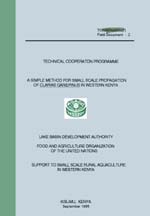
David Campbell
Chief Technical Advisor
Food and Agriculture Organization
Shem Obuya
Fisheries Officer
Lake Basin Development Authority
Micheal Spoo
Farm Supervisor
Lake Basin Development Authority
| Field Document No. 2 | TCP/KEN/4551(T) |
 | A simple method for small scale propagation of Clarias gariepinus in Western Kenya Based on the work ofDavid Campbell Chief Technical Advisor Food and Agriculture Organization Shem Obuya Fisheries Officer Lake Basin Development Authority Micheal Spoo Farm Supervisor Lake Basin Development Authority |
LAKE BASIN DEVELOPMENT AUTHORITY
FOOD AND AGRICULTURE ORGANIZATION OF THE UNITED NATIONS
SUPPORT TO SMALL SCALE RURAL AQUACULTURE IN WESTERN KENYA
KISUMU, KENYA
September 1995
This field document presents the initial results of a series of trials undertaken in 1995 with the objective to defining a simple method of propagation of Clarias gariepinus for rural fish farmers in western Kenya. The work was undertaken in the Western, Nyanza, and Rift Valley Provinces of Kenya under the auspices of the Lake Basin Development Authority, in collaboration with the FAO Technical Cooperation Programme TCP/KEN/4551 (T) “Support to Small Scale Rural Aquaculture in Western Kenya”. The paper is primarily addressed to the project staff and other workers in the field who may encounter similar situations.
This Field Document is one of a series of reports prepared during the course of the project identified on the title page. The conclusions and recommendations given in the report are those considered appropriate at the time of its preparation. They may be modified in the light of further knowledge gained at subsequent stages of the project.
The designations employed and the presentation of the material in this document do not imply the expression of any opinion whatsoever on the part of the United Nations or the Food and Agriculture Organization of the United Nations concerning the legal status of any country, territory, city or area or of its authorities, or concerning the delimitation of its frontiers or boundaries.
Campbell.D., S. Obuya, and M. Spoo. 1995. A simple method for small scale propagation of Clarias gariepinus in western Kenya. TCP/KEN/4551(T) Field Document No 2. Kisumu, Kenya.
This paper describes in detail a simple system for propagating Clarias gariepinus on a small scale using semi-artificial methods and water syphoned from a fish pond. A filtration system made of plastic buckets and foam mattress pads is described and recommended. Fish spawned in a 32 I plastic basin on a stone chip substrate. In 65 spawning trials, 168 773 Clarias larvae were produced. Results were significantly better with 1 spawning couple per container than with 2 pair of breeders (P<0.05). Expected yield is 3 985 + / 1 090 (S.E.M.) larvae when using 1 spawning pair. Females died in 12 % of the trials before spawning occurred. Preliminary results (7 trials) using a net barrier to separate the breeders in the spawning container indicate that this barrier is effective in reducing breeder mortality and in no way inhibits spawning.
Larval C. gariepinus were stocked in either a 50 m2 (4 trials) or very small 10 m2 ponds measuring 1 m × 10m × 30 cm depth (22 trials) at a density of 100 to 500 larvae /m2. The ponds were completely covered with a 4 mm mesh nylon net to prevent frogs and other predators from entering the pond. Ponds were initially fertilized at a rate of 2 to 4 kg/m2 composted chicken litter and fed 50 g /day on a feed composed of 20% fish meal, 20% cotton seed cake, and 60% rice bran. This feed was hammer-milled then sieved through a 1 mm mesh. Larval survival was 31 %. A mean value of 85 fish /m2 weighing 0.1 to 1 g was obtained from the 10 m2 ponds following a rearing period of 14 to 28 days. Growth does not appear to be limited by the very small pond environment. The larger 50 m2 ponds are not recommended as they are more difficult to protect from predation. The preliminarily results from the very small protected ponds are very promising with the mean value of 85 fish/m2 at harvest 3 to 4 times higher than that of previous work in Kenya and results cited in the literature. More studies are needed to determine the optimum growing period, stocking density and supplementary feed in very small ponds. The use of several 10 m2 ponds is recommended for future research as a means of quickly obtaining the numerous repetitions needed for comparative treatments.
Hyperlinks to non-FAO Internet sites do not imply any official endorsement of or responsibility for the opinions, ideas, data or products presented at these locations, or guarantee the validity of the information provided. The sole purpose of links to non-FAO sites is to indicate further information available on related topics.
This electronic document has been scanned using optical character recognition (OCR) software. FAO declines all responsibility for any discrepancies that may exist between the present document and its original printed version.
LIST OF ABREVIATIONS
2.2 Spawning and incubation container
2.4 Semi-artificial spawning of C. gariepinus
3.2 Semi-artificial spawning of C. gariepinus
3.3 Rearing of larval Clarias in protected ponds
4. Conclusions and recommendations
appendix i Detailed results from semi-artificial spawning
LIST OF FIGURES
Figure 1 Drawing of spawning system
LIST OF TABLES
Table I Comparison of 1 or 2 spawning couples
Table II Results of pond rearing Clarias larvae